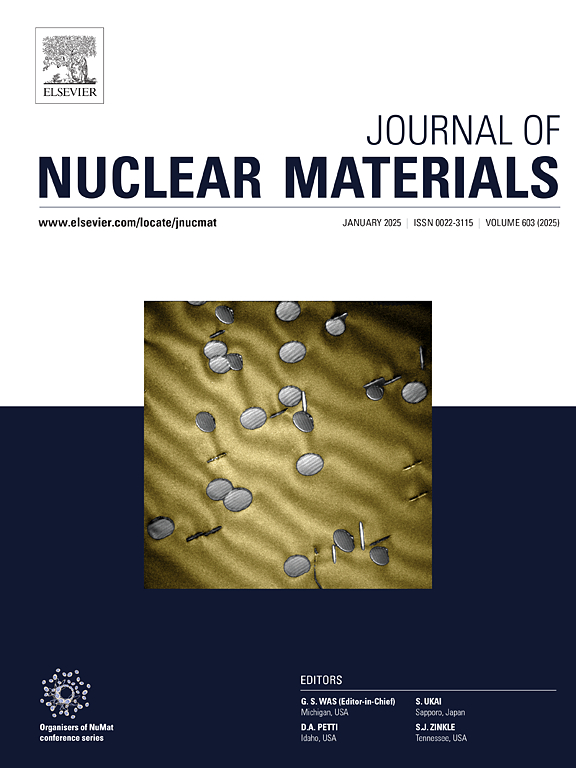Coordination-driven mixing behavior of corrosion and fission products in NaCl-UCl₃ molten salt
IF 3.2
2区 工程技术
Q3 MATERIALS SCIENCE, MULTIDISCIPLINARY
引用次数: 0
Abstract
Molten salts play a crucial role in Generation IV nuclear energy technology, with chloride salts like NaCl-UCl3 garnering significant attention due to their distinctive properties and potential applications in fast-spectrum molten salt reactors (MSRs). The corrosive nature of molten salts can cause the dissolution of structural materials, leading to the formation of new species in molten chlorides. In addition, the radioactive decay of nuclear fuels results in the accumulation of fission products in the salts. Understanding the behavior of these corrosion and fission products and their impacts on the properties of molten salts is critical for the design of MSRs. This paper presents a systematic study on the properties of eutectic NaCl-UCl3 molten salt in the presence of corrosion products (CrCl2 and CrCl3) and fission products (CsCl and SrCl2) utilizing ab initio molecular dynamics (AIMD) simulations. We focus on essential structural and thermophysical properties such as density, mixing energy, coordination numbers (CN), and Radial Distribution Functions (RDF) with varying compositions of these corrosion and fission products from 0 % to 15.8 %. It is found that the mixing behavior of these corrosion and fission products is strongly driven by their coordination chemistry in eutectic NaCl-UCl3. Both CrCl2 and SrCl2 have identical coordination to eutectic NaCl-UCl3, thus exhibit negative mixing energies at a lower concentration. In contrast, CsCl exhibits significant different coordination compared to NaCl-UCl3, resulting to positive mixing energies. Our results offer valuable insights into the coordination chemistry and mixing behavior of corrosion and fission products in chloride molten salts and provide essential data that can be used as input to property databases to supplement experimental data.
NaCl-UCl₃熔盐中腐蚀与裂变产物配位驱动的混合行为
熔盐在第四代核能技术中起着至关重要的作用,像NaCl-UCl3这样的氯化物盐由于其独特的特性和在快谱熔盐反应堆(MSRs)中的潜在应用而受到了极大的关注。熔融盐的腐蚀性会导致结构材料的溶解,导致熔融氯化物中新物质的形成。此外,核燃料的放射性衰变导致裂变产物在盐中积累。了解这些腐蚀和裂变产物的行为及其对熔盐性能的影响对MSRs的设计至关重要。本文利用从头算分子动力学(AIMD)模拟系统地研究了腐蚀产物(CrCl2和CrCl3)和裂变产物(CsCl和SrCl2)存在时共晶NaCl-UCl3熔盐的性能。我们关注基本的结构和热物理性质,如密度、混合能、配位数(CN)和径向分布函数(RDF),这些腐蚀和裂变产物的组成从0%到15.8%不等。在共晶NaCl-UCl3中,这些腐蚀产物和裂变产物的混合行为受到它们的配位化学作用的强烈驱动。CrCl2和SrCl2与共晶NaCl-UCl3具有相同的配位,因此在较低浓度下呈现负混合能。相比之下,CsCl与NaCl-UCl3具有显著的配位差异,导致混合能为正。我们的结果为氯化物熔盐中腐蚀和裂变产物的配位化学和混合行为提供了有价值的见解,并提供了必要的数据,可以用作属性数据库的输入,以补充实验数据。
本文章由计算机程序翻译,如有差异,请以英文原文为准。
求助全文
约1分钟内获得全文
求助全文
来源期刊

Journal of Nuclear Materials
工程技术-材料科学:综合
CiteScore
5.70
自引率
25.80%
发文量
601
审稿时长
63 days
期刊介绍:
The Journal of Nuclear Materials publishes high quality papers in materials research for nuclear applications, primarily fission reactors, fusion reactors, and similar environments including radiation areas of charged particle accelerators. Both original research and critical review papers covering experimental, theoretical, and computational aspects of either fundamental or applied nature are welcome.
The breadth of the field is such that a wide range of processes and properties in the field of materials science and engineering is of interest to the readership, spanning atom-scale processes, microstructures, thermodynamics, mechanical properties, physical properties, and corrosion, for example.
Topics covered by JNM
Fission reactor materials, including fuels, cladding, core structures, pressure vessels, coolant interactions with materials, moderator and control components, fission product behavior.
Materials aspects of the entire fuel cycle.
Materials aspects of the actinides and their compounds.
Performance of nuclear waste materials; materials aspects of the immobilization of wastes.
Fusion reactor materials, including first walls, blankets, insulators and magnets.
Neutron and charged particle radiation effects in materials, including defects, transmutations, microstructures, phase changes and macroscopic properties.
Interaction of plasmas, ion beams, electron beams and electromagnetic radiation with materials relevant to nuclear systems.
 求助内容:
求助内容: 应助结果提醒方式:
应助结果提醒方式:


